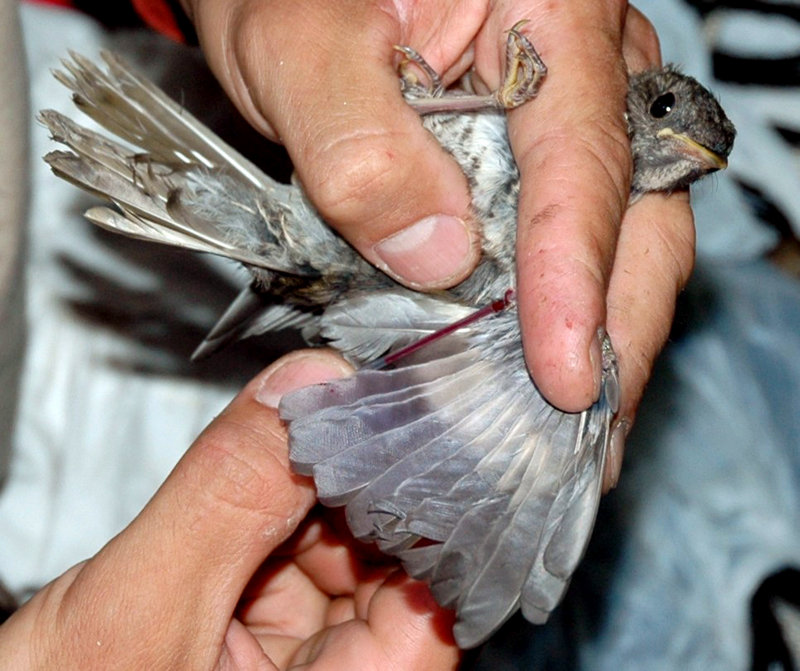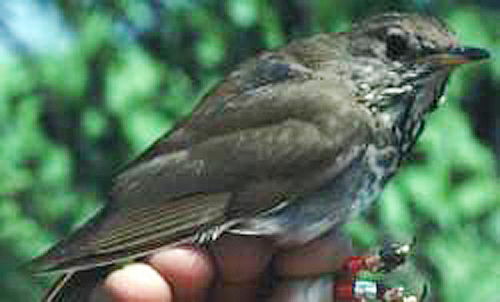A bird that ornithologists, birders and wind-power opponents say is at risk from developments ranging from mountaintop wind turbines to ski resorts could get federal protection.
The Bicknell’s thrush – a medium-sized migrating songbird – has cleared the first stage of a long route that could lead to it being declared a threatened or endangered species, the U.S. Fish and Wildlife Service announced Tuesday.
At issue is the bird’s habitat as much as its numbers, because the terrain that the Bicknell’s thrush favors is almost exactly the same as that sought by wind-energy companies, foresters and tourism developers.
Even before Tuesday’s announcement, Maine conservationists and wind-power critics had raised concerns about the possible negative impacts of wind-power projects on habitat used by the Bicknell’s thrush. There currently are 195 turbines built or under contract in Maine, representing an investment of nearly a billion dollars, according to the website windforme.org.
“Bicknell’s thrushes were a big issue” at the 44-turbine Kibby Mountain and Redington Farm/Black Nubble wind projects, said Chris O’Neil, a Portland lobbyist and volunteer president of Friends of Maine Mountains, which opposes the proliferation of wind power in the state.
He expects that the bird’s fate will continue to play a role in the continuing controversy over wind projects in Maine, because such projects can pose “a real threat … that you ruin their habitat to a detrimental degree.”
“People pooh-pooh a silly little bird,” O’Neil said. But Americans have a long tradition of showing that they “take seriously rendering a species extinct.”
It is still a long way to go before the bird could be listed as threatened or endangered, officials said. The first stage – an internal evaluation of the information that the Fish and Wildlife Service already has on the Bicknell’s thrush – has been completed.
Now the agency will conduct an external review, consulting with scientists, academics, birding experts and other interested parties to try to figure out how imperiled the bird is and what protective status it might require to ensure it isn’t further depleted or driven extinct.
“The Bicknell’s thrush has one of the most limited breeding ranges of any bird on the continent, nesting at the highest elevations in Maine, New Hampshire, New York and Vermont,” the Fish and Wildlife Service wrote in its announcement Tuesday. Across their range, they breed in very specific habitat – stunted spruce and balsam fir forests in the northernmost and higher elevations of New England – including Maine – and southern Canada, the Fish and Wildlife Service said.
The thrush’s habitat “obviously collides with wind power,” said state Rep. Bob Duchesne, D-Hudson, a member of the board of trustees of the Maine Audubon Society and creator of Maine Birding Trails, a birding guide.
But Fish and Wildlife Service officials said no one should draw any conclusions at this stage.
“It’s very early” in the process, and it’s not clear how long the external review will take, said Meagan Racey, spokeswoman for the Northeast Region of the Fish and Wildlife Service.
The review is likely to take more than a year to complete, because there are numerous similar assessments on other species to be conducted, and this one is not at the top of the heap.
However, Racey said, the Bicknell’s thrush “is a rare bird of huge interest (and) a priority in the international birding community.”
“Let’s let the science dictate the policy,” said Jeremy Payne, executive director of Maine Renewable Energy, a nonprofit industry association in Augusta. “More analysis sounds OK.”
Payne pointed out, however, that climate change is also listed as a threat to the Bicknell’s thrush. It would be “very ironic,” he said, if the bird ultimately were listed as threatened or endangered and that status had the effect of “interrupting, delaying or derailing” alternative-energy projects.
If renewable energy is restricted to protect this bird’s habitat, it might result in further dependence on fossil fuels and continuing emissions from coal plants that could have an equivalent, or worse, impact on the habitat, Payne said.
“We’ve got to be careful about the policies we implement,” he said, adding that he hoped the Fish and Wildlife Service would “take a long, hard look and play this out all the way through.”
If the trees in which the thrush lives from May to November disappear, the bird could lose not only its breeding habitat but also some of its food sources, which include insects and berries, said Tom Chapman, field supervisor for the New England Field Office of the Fish and Wildlife Service in Concord, N.H.
In reviewing the bird’s status, officials will consider “many, many variables,” he said, before deciding whether it should become a candidate for listing as threatened or endangered.
Even if it eventually got listed as threatened or endangered, “it doesn’t preclude development” such as logging, tourism or renewable energy, he said. There still would be ways that industry or developers could modify project plans to reduce threats to the bird.
“It’s a priority to work with the wind power industry,” said Racey. The Fish and Wildlife Service would work with developers to try to reach a satisfactory compromise, but its overarching mandate is to protect stressed species.
For a species to be declared “threatened,” it must be likely to become endangered in part or all of its range. And for it to be deemed “endangered,” it must be likely to become extinct in part or all of its range.
Once a species is listed as either threatened or endangered, the federal government can take steps to protect habitat or reduce other threats.
Audubon’s Duchesne said the Bicknell’s thrush is special because it is rarely seen below an altitude of 3,000 feet – and they “sing only at dawn and dusk on mountaintops.”
According to the International Bicknell’s Thrush Conservation Group, the bird’s numbers have declined to about 125,000 globally. Over the past 10 years, U.S. populations have been more stable than those in Canada, which have shown “steep declines … due to habitat loss,” the Fish and Wildlife Service reported.
“That’s a very small number for a species,” Duchesne said. By comparison, there are “easily millions and millions of robins,” he said. Even “puffins are very numerous.”
The birds spend the time from May to November breeding in high-altitude fir forests in the northeastern U.S. and southeastern Canada.
For the winter, they migrate to the Caribbean. An estimated 90 percent of the global population is concentrated on the island of Hispaniola – home to the Republic of Haiti and the Dominican Republic – where forested habitats have been reduced significantly, and where predation also has been a problem.
The Bicknell’s thrush is one of the land-bird species of highest conservation concern in North America, and the species is threatened by loss of its breeding habitat not just to wind power, but also to “recreational development, telecommunication construction acidic precipitation, mercury deposition and climatic warming,” the Bicknell’s thrush group has reported.
O’Neil conceded that acid rain, toxic emissions and global warming can contribute to “changing our forests from fir to hardwood,” and all contribute to the bird’s decline.
“I work for an environmental group that takes all species seriously, from the Bicknell’s thrush to homo sapiens,” O’Neil said. “And because the laws are so stacked in favor of wind power we gladly accept whatever assistance we can get, even if it comes from a little bird.
“Ask Angus King what he thinks of it,” O’Neil said.
King, a U.S. Senate candidate and former Maine governor, faced the issue of the Bicknell’s thrush as the head of Independence Wind. It came up during the 2010 regulatory review of a request for a permit from his Brunswick-based firm for a $210 million, 39-turbine project in the Bigelow Preserve.
“And,” said O’Neil, “he didn’t get it.”
Staff Writer North Cairn can be contacted at 791-6325 or at: ncairn@mainetoday.com
Send questions/comments to the editors.




Success. Please wait for the page to reload. If the page does not reload within 5 seconds, please refresh the page.
Enter your email and password to access comments.
Hi, to comment on stories you must . This profile is in addition to your subscription and website login.
Already have a commenting profile? .
Invalid username/password.
Please check your email to confirm and complete your registration.
Only subscribers are eligible to post comments. Please subscribe or login first for digital access. Here’s why.
Use the form below to reset your password. When you've submitted your account email, we will send an email with a reset code.